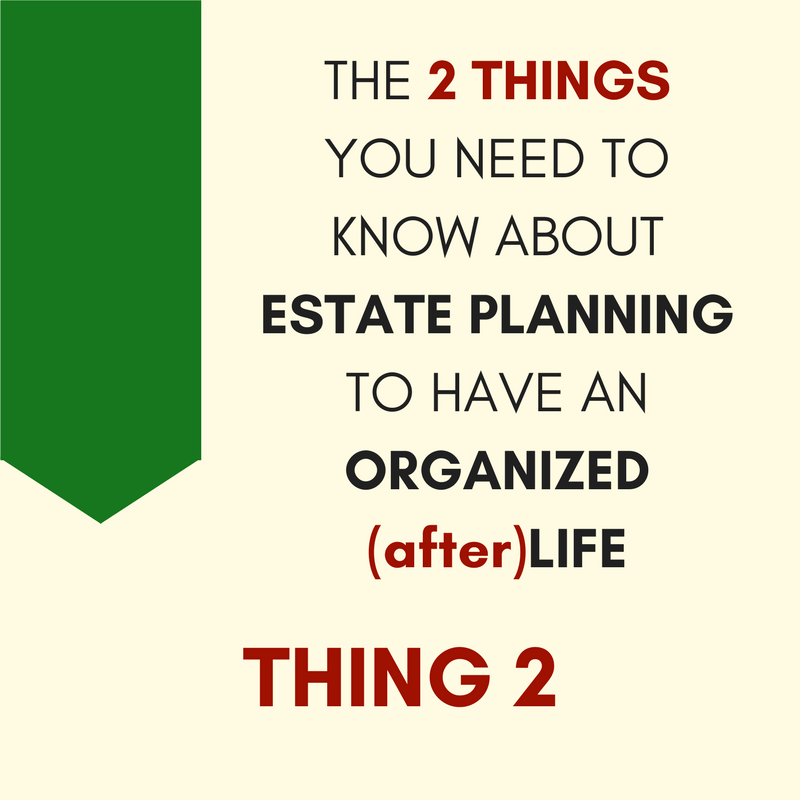
01 May The Two Things You Need To Understand About Estate Planning. Thing 2.
So. Last time I talked about Thing 1 of the Two Things You Need To Understand About Estate Planning. Thing 1 is the first type of property you can have: non-probate assets. Because there’s a document specific for that asset that directs it to automatically go to someone when you die, it doesn’t go to your estate. It moves quickly on to the next owner. Now, I’ll talk about the other thing you need to know. Probate Assets.

Thing 2 is anything that doesn’t move automatically. When there’s no document that says where the asset automatically goes when you die, it goes by default to your estate. These type of assets called probate assets. And they’re “stuck”.

You need some sort of legal process so that someone can get authority to collect and distribute your estate appropriately. In the meantime, everything stops. Depending on where the assets are located and the amounts and types of assets involved, the process to get them moving could be relatively simple or complex and drawn out.
So where do your assets go? Who has the authority? That’s where a will comes in. A will is simply your directions for your probate assets. The purpose of a will is to say where your probate assets go and who has the authority to deal with it. A part of the process to get someone authority to deal with your assets, will be to determine the will is the right one to follow.
What happens when you don’t have a will? Well, the state applies its “intestacy” law. Intestacy means “no” (in) and “will” (testate). Intestacy law fills in the blanks. It makes presumptions of where your stuff should go and who should get it there, usually based on your family situation. For some people, those presumptions work. For many others, they don’t.
Whether you have a will or whether the state fills in the blanks, a specific process is followed. Those formalities can slow down the transfer. For some people, that’s inefficient. For some people, the formalities can actually be a benefit. But in any case, there’s a process to get those things to (eventually) move.

Figuring out whether you show have particular assets move automatically (Thing 1), or go through a legal process in your estate (Thing 2), is a question you should consider. Contrary to popular belief, there isn’t a single answer for everyone. In the coming weeks, I’ll talk about how to make more assets move automatically and when someone might actually benefit from things being “stuck”.



Pingback:The Two Things You Need To Understand About Estate Planning. Thing 1. – An Organized (after)Life
Posted at 21:20h, 02 May[…] want to know about what a will does, don’t you? Like I said, that deals with probate assets. Thing 2. We’ll get to that […]
Pingback:What is a Will? – An Organized (after)Life
Posted at 08:20h, 15 May[…] new information. Wills say what happens to assets that are “stuck”. Assets that are Thing 2 assets. These are the assets that don’t have some document out there that says what happens […]
Pingback:What is Probate? – An Organized (after)Life
Posted at 21:15h, 26 June[…] when I talked about the two things everyone needs to know to organized their (after)life? “Thing 2” was what didn’t automatically transfer to someone else or what wasn’t held in […]
Pingback:Probate Terms – An Organized (after)Life
Posted at 22:07h, 29 October[…] Estate: assets of a deceased individual not directed to automatically transfer. Also called probate assets. […]
Pingback:Free Free Free. - An Organized (after)Life
Posted at 15:12h, 24 November[…] written about the two types of assets… Thing 1/non-probate/automatic and Thing 2/probate/stuck assets. I’ve also talked about understanding Thing 1 and Thing 2 are the two things you need […]